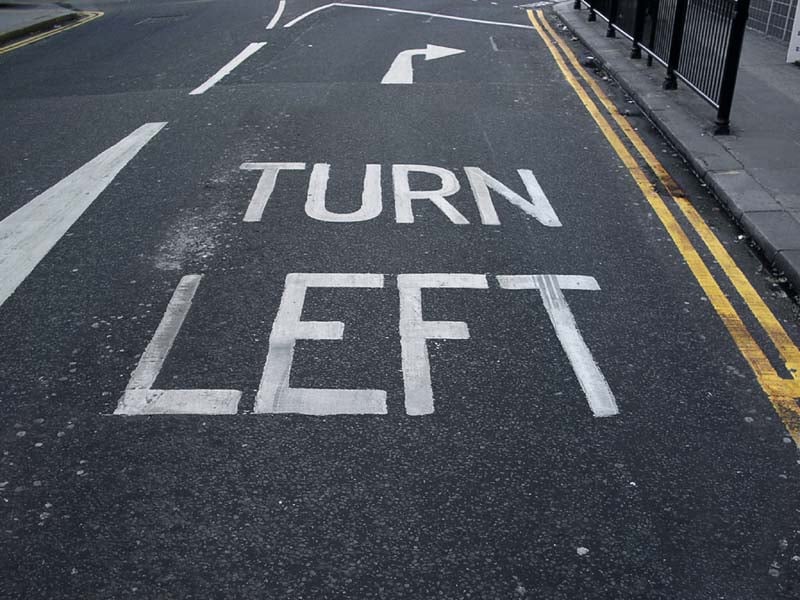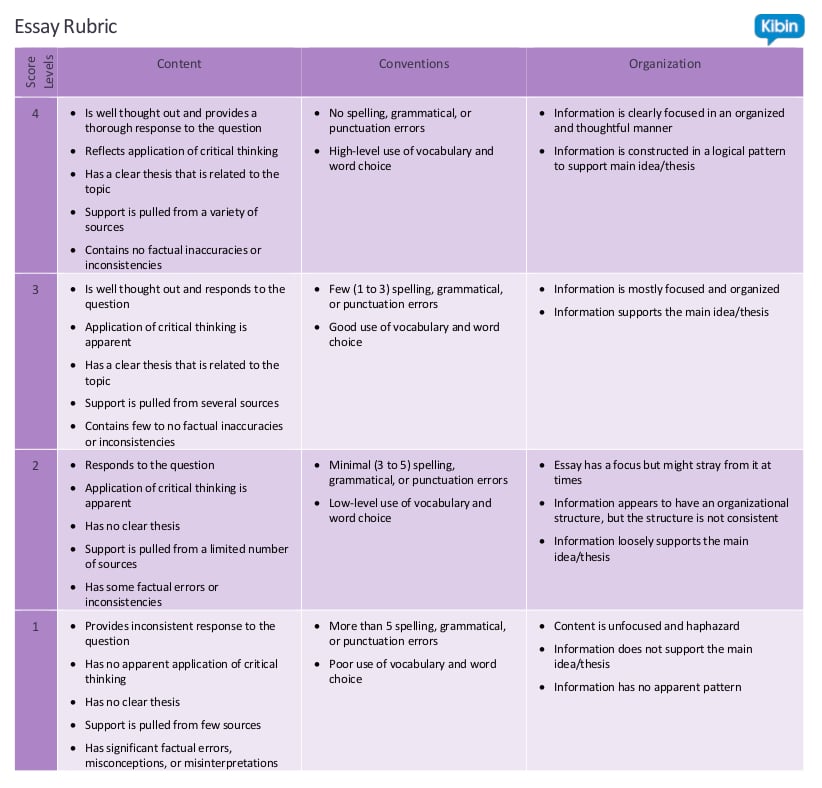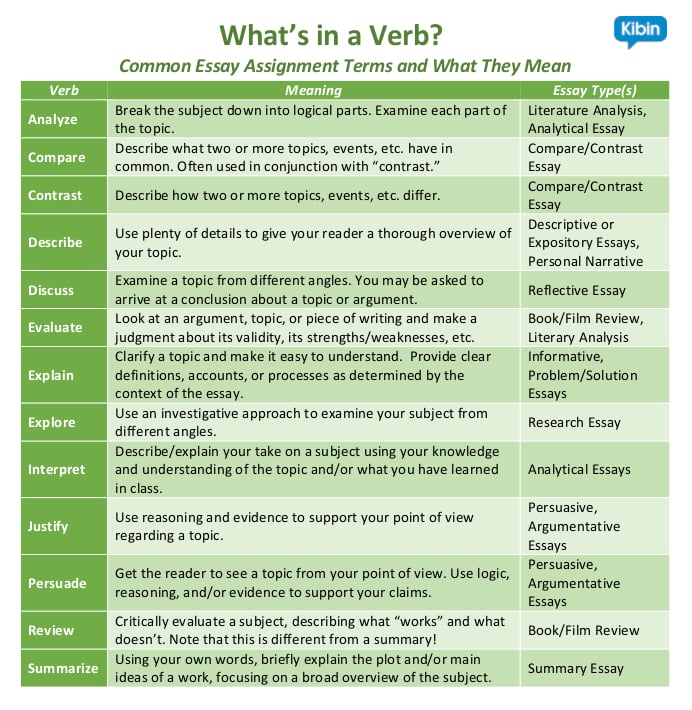If there’s one thing I’ve learned in my 30 years on this planet, it’s that you should always read the instructions.

Okay, most of the time.
At any rate, I know that you should read the instructions on tests. I learned this by accidentally skipping two pages of the math section on the SAT. Apparently, when they say “continue to the next page,” they mean that.
You should also read the instructions while assembling household goods. Who knew that you needed to pull upward on a lawnmower handle in order for the blade to move for the first time?
The manual, that’s who.
And most importantly, you should read the instructions for writing essays.
Knowing how to read and understand an essay assignment isn’t always as straightforward as it sounds. Subtle distinctions exist between words such as “analyze” and “describe,” for instance. And what does your teacher really mean when he or she says you need to “evaluate the literary significance of the long 18th century”?
This post will teach you how to unpack, decipher, and truly understand an essay assignment so that you can deliver exactly what your teacher is looking for.
Why Do You Need to Read Your Essay Assignment in the First Place?
Your teacher gave a quick rundown of the assignment in class, so you don’t really need to read it again, right?
Wrong. (Yeah, you knew I was going to say that.)
While your teacher was explaining the assignment at the end of class, you were doodling in your notebook and tapping your foot as you eyed the clock, anxiously awaiting the moment you could scurry home to your cat, couch, and/or Netflix.
Not that I’d, uh, know anything about that.
Even if you were paying attention, that’s a lot of information to absorb, especially if you’re not an auditory learner.
Besides that, you wouldn’t bake a cake without reading a recipe or take an eight-hour road trip without looking at a map, would you?
I mean, you could, but I’m not sure I want to be your taste-tester or your passenger.

Similarly, not reading your essay assignment is a good way to mess up the “ingredients” of your essay or cover a lot of unnecessary ground.
Your teacher knows all of this!
That’s why you have a written assignment: you can review the parameters of the essay, refer back to the assignment as you plan your essay, resituate yourself as you write, and check your final writing against the assignment.
But how do you understand exactly what your teacher is asking?
How to Decode an Essay Assignment
Whether your essay assignment is a few short sentences or a full page, there’s a lot to unpack and decode in order to figure out exactly what your teacher is asking you to write. Let’s look at some of the words and phrases you’ll likely encounter in your assignment and what exactly they mean.
Verbs that denote purpose and form
The verbs your teacher uses in an essay assignment serve as important clues about the type of content you should write and the form your essay should take.
The following table features a list of verbs that often appear in essay assignments, along with their meanings and the types of essays that are often (but not always!) associated with them.
And don’t forget, you can also check out examples of all these essay types in !
Words that define scope and limitations
Verbs aren’t the only important words to decode in an essay assignment. Most assignments will also contain words or phrases that define the scope of the response your teacher expects from you.
This has nothing to do with fresh breath and everything to do with how deeply or shallowly you delve into your topic. It’s the difference between, say, a six-word story and a Ken Burns documentary.
The ideal scope means your essay’s focus is not too broad, and not too narrow: it’s just right.

Sometimes, your teacher may define scope using numbers:
- “Compare and contrast two authors” [This means exactly two.]
- “Providing at least three main ideas” [This could include three, four, or more main ideas.]
- “In no more than six pages” [This means probably at least four or five, but definitely not seven.]
These phrases give you an idea of the number of examples you should provide or how many main points your essay should cover. Watch out for phrases such as “at least,” “no more than,” and similar phrasing.
Your teacher may also set limitations using references to time:
- “Events during the early 17th century” [Not the middle 17th century or the late 16th.]
- “That have occurred in recent history” [You probably shouldn’t discuss a subject from the 1950s, then.]
- “Modern technology” [This is open to interpretation, but this probably doesn’t refer to technology from the 1980s.]
- “How it has changed in the past 10 years” [Not only in the past 5 years, and not in the past 15—just 10.]
Time references define the scope of your essay by specifying where your coverage should begin and end. This ensures that you aren’t covering a time period that is too broad, meaning that you can give only a minor overview of the subject, or a period that is too narrow, meaning that you don’t have enough to write about.
Words that define format/style
Last but not least, check your essay assignment for terms that dictate how your paper should look and how you should cite your sources.
Your instructor may provide explicit essay formatting requirements:
- “12-pt Times New Roman”
- “1-inch margins”
- “Include a cover page”
If you see specific instructions like these, then you should definitely use them as you format your paper! There is no easier way to rack up points toward a good grade.
Sometimes, however, your instructor will only specify a style guide:
- “Use MLA format”
- “Please adhere to APA guidelines”
These phrases indicate that you should use these style guides to cite any sources you consult for your essay.
But MLA and APA aren’t only systems for citing sources. These style guides also provide guidelines for formatting essays and reports, including guidance on fonts, margins, headers, and more. Often, they also tell you how to handle numbers, abbreviations, and other considerations.
In the absence of any other formatting guidelines in your essay assignment, it’s a good idea to consult the style guide.
Read How to Write MLA Citations Without Going Crazy or How to Write APA Citations in 4 Easy Steps for help with citing your sources, and check out the Purdue Owl’s MLA and APA pages for formatting guidelines.
You can also check out our Essay Formatting Survival Guide for other formatting tips.
If all else fails and you genuinely don’t understand what your instructor is asking for, take advantage of the instructor’s office hours. Schedule a meeting to discuss the essay assignment.
It’s always better to clear up your confusion before you start writing instead of after your essay is done. But it’s also a good idea to check your work and make sure that you’ve hit all of the important points of the assignment.
How to Make Sure Your Completed Essay Fits the Assignment
There are a few ways that you can check your completed essay against the assignment to ensure that you didn’t miss the mark completely or leave anything out.
One of my favorite strategies is to create a checklist from the essay assignment before I ever start writing. You could make such a checklist as detailed or as basic as you want, but you definitely should include all of the most important elements of the assignment.
If you don’t have time to create your own, this comprehensive essay editing checklist from the University of New South Wales should help ensure you covered all your bases.
If you’re lucky, your teacher will include a rubric with your essay assignment. A rubric generally breaks down the assignment into specific components, such as content, support, style, and mechanics/grammar.
It also generally tells you what you need to accomplish in each area to achieve the highest grade. This can actually serve as a checklist itself, saving you a bit of time and trouble.
Here’s an example of a rubric:

Another strategy for checking your essay against the prompt is creating a reverse outline. Reverse outlining is actually a great first step for revising any essay. It helps you identify holes in your argument, missing details, and other important elements you might have forgotten.
Check out this helpful handout from Duke University, or use this reverse outlining worksheet from the Berkeley Student Learning Center.
Finally, you can have your essay checked by a . Not only can we help you proofread your essay, but we can also help ensure your essay sticks to the assignment.
After you upload your essay, you have the option to include a supplemental document, such as your essay assignment or a rubric. Personally, I love when students use this feature. It not only gives me better context for what you’ve written, but I can tailor my feedback and editing to help you make sure you covered everything you needed to cover.
Ultimately, an essay assignment may seem intimidating, but you should think of it as the roadmap to a killer grade. A recipe for success. A blueprint for … well, you get the idea.
Happy writing!
